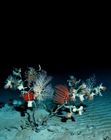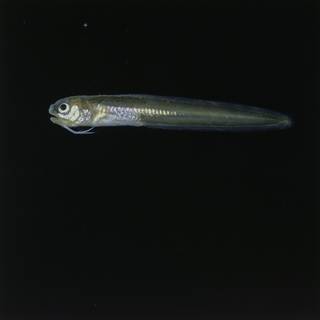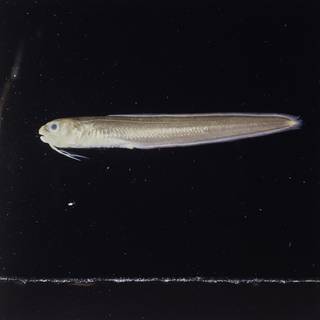WoRMS taxon details
Ophidiidae Rafinesque, 1810
- Subfamily Brotulinae Swainson, 1838
- Genus Brotula Cuvier, 1829
- Subfamily Brotulotaeniinae Cohen & Nielsen, 1978
- Genus Brotulotaenia Parr, 1933
- Genus Brotulaenia accepted as Brotulotaenia Parr, 1933 (misspelling)
- Genus Brotulataenia accepted as Brotulotaenia Parr, 1933 (misspelling)
- Genus Brotulateania accepted as Brotulotaenia Parr, 1933 (misspelling)
- Genus Menziesichthys Nalbant & Mayer, 1971
- Subfamily Neobythitinae Radcliffe, 1913
- Genus Abyssobrotula Nielsen, 1977
- Genus Acanthonus Günther, 1878
- Genus Alcockia Goode & Bean, 1896
- Genus Apagesoma Carter, 1983
- Genus Barathrites Zugmayer, 1911
- Genus Barathrodemus Goode & Bean, 1883
- Genus Bassogigas Goode & Bean, 1896
- Genus Bassozetus Gill, 1883
- Genus Bathyonus Goode & Bean, 1885
- Genus Benthocometes Goode & Bean, 1896
- Genus Dannevigia Whitley, 1941
- Genus Dicrolene Goode & Bean, 1883
- Genus Enchelybrotula Smith & Radcliffe, 1913
- Genus Epetriodus Cohen & Nielsen, 1978
- Genus Eretmichthys Garman, 1899
- Genus Glyptophidium Alcock, 1889
- Genus Holcomycteronus Garman, 1899
- Genus Homostolus Smith & Radcliffe, 1913
- Genus Hoplobrotula Gill, 1863
- Genus Hypopleuron Smith & Radcliffe, 1913
- Genus Lamprogrammus Alcock, 1891
- Genus Leptobrotula Nielsen, 1986
- Genus Leucicorus Garman, 1899
- Genus Luciobrotula Smith & Radcliffe, 1913
- Genus Mastigopterus Smith & Radcliffe, 1913
- Genus Monomitopus Alcock, 1890
- Genus Neobythites Goode & Bean, 1885
- Genus Neobythitoides Nielsen & Machida, 2006
- Genus Penopus Goode & Bean, 1896
- Genus Petrotyx Heller & Snodgrass, 1903
- Genus Porogadus Goode & Bean, 1885
- Genus Pycnocraspedum Alcock, 1889
- Genus Selachophidium Gilchrist, 1903
- Genus Sirembo Bleeker, 1857
- Genus Spectrunculus Jordan & Thompson, 1914
- Genus Spottobrotula Cohen & Nielsen, 1978
- Genus Tauredophidium Alcock, 1890
- Genus Tenuicephalus Schwarzhans & Møller, 2021
- Genus Thalassobathia Cohen, 1963
- Genus Typhlonus Günther, 1878
- Genus Ventichthys Nielsen, Møller & Segonzac, 2006
- Genus Xyelacyba Cohen, 1961
- Genus Bassobythites Brauer, 1906 accepted as Lamprogrammus Alcock, 1891
- Genus Bathynectes Günther, 1878 accepted as Bathyonus Goode & Bean, 1885
- Genus Brotella Kaup, 1858 accepted as Sirembo Bleeker, 1857
- Genus Celema Goode & Bean, 1896 accepted as Porogadus Goode & Bean, 1885
- Genus Dermatorus Alcock, 1890 accepted as Porogadus Goode & Bean, 1885
- Genus Dicromita Goode & Bean, 1896 accepted as Monomitopus Alcock, 1890
- Genus Grimaldichthys Roule, 1913 accepted as Holcomycteronus Garman, 1899
- Genus Hoprobrotula accepted as Hoplobrotula Gill, 1863 (misspelling)
- Genus Itatius Matsubara, 1943 accepted as Pycnocraspedum Alcock, 1889
- Genus Mixonus Günther, 1887 accepted as Bathyonus Goode & Bean, 1885
- Genus Monomeropus Garman, 1899 accepted as Monomitopus Alcock, 1890
- Genus Monomitopsis accepted as Monomitopus Alcock, 1890 (misspelling)
- Genus Neobythes accepted as Neobythites Goode & Bean, 1885 (misspelling)
- Genus Paradicrolene Alcock, 1889 accepted as Dicrolene Goode & Bean, 1883
- Genus Poragadus accepted as Porogadus Goode & Bean, 1885 (unaccepted > misspelling - incorrect subsequent spelling)
- Genus Pseudobythites Meek & Hildebrand, 1928 accepted as Petrotyx Heller & Snodgrass, 1903
- Genus Pteroidonus Günther, 1887 accepted as Dicrolene Goode & Bean, 1883
- Genus Umalius Herre & Herald, 1950 accepted as Sirembo Bleeker, 1857
- Genus Volcanus Gosline, 1954 accepted as Luciobrotula Smith & Radcliffe, 1913
- Genus Watasea Jordan & Snyder, 1901 accepted as Neobythites Goode & Bean, 1885
- Subfamily Ophidiinae Rafinesque, 1810
- Genus Cherublemma Trotter, 1926
- Genus Chilara Jordan & Evermann, 1896
- Genus Genypterus Philippi, 1857
- Genus Lepophidium Gill, 1895
- Genus Ophidion Linnaeus, 1758
- Genus Otophidium Gill, 1885
- Genus Parophidion Tortonese, 1954
- Genus Raneya Robins, 1961
- Genus Xiphiurus Smith, 1847
- Genus Brotuloides Robins, 1961 accepted as Cherublemma Trotter, 1926
- Genus Hoplophycis Kaup, 1858 accepted as Genypterus Philippi, 1857
- Genus Leptophidium Gill, 1863 accepted as Lepophidium Gill, 1895
- Genus Lopophidium accepted as Lepophidium Gill, 1895 (misspelling)
- Genus Ophidium Linnaeus, 1766 accepted as Ophidion Linnaeus, 1758 (misspelling)
- Genus Paraphidion accepted as Parophidion Tortonese, 1954 (misspelling)
- Genus Rissola Jordan & Evermann, 1896 accepted as Ophidion Linnaeus, 1758
marine, brackish, fresh, terrestrial
Not documented
Description Chiefly marine (rarely freshwater). Distribution: Atlantic, Indian, and Pacific Oceans. Anus and anal fin origin usually...
Description Chiefly marine (rarely freshwater). Distribution: Atlantic, Indian, and Pacific Oceans. Anus and anal fin origin usually posterior to pectoral fin tip. Anal fin rays usually of the same length or shorter than opposing dorsal fin rays. Scales present. One or more opercular spines in some. Supramaxillary present. Vexillum lacking in larvae. Pelvics usually present. About 1.5 m maximum length. [details]
Froese, R. and D. Pauly. Editors. (2024). FishBase. Ophidiidae Rafinesque, 1810. Accessed through: World Register of Marine Species at: https://www.marinespecies.org/aphia.php?p=taxdetails&id=125505 on 2024-11-21
Date
action
by
![]() The webpage text is licensed under a Creative Commons Attribution 4.0 License
The webpage text is licensed under a Creative Commons Attribution 4.0 License
taxonomy source
Van Der Laan, R.; Eschmeyer, W. N.; Fricke, R. (2014). Family-group names of Recent fishes. <em>Zootaxa.</em> 3882(1): 1-230., available online at https://doi.org/10.11646/zootaxa.3882.1.1 [details] Available for editors  [request]
[request]
context source (PeRMS) Chirichigno, N.; Cornejo, M. (2001). Catálogo comentado de los peces marinos del Perú. <em>2ª ed. Instituto del Mar de Perú. Publicación Especial. Callao.</em> 314 p. [details]
basis of record van der Land, J.; Costello, M.J.; Zavodnik, D.; Santos, R.S.; Porteiro, F.M.; Bailly, N.; Eschmeyer, W.N.; Froese, R. (2001). Pisces, <B><I>in</I></B>: Costello, M.J. <i>et al.</i> (Ed.) (2001). <i>European register of marine species: a check-list of the marine species in Europe and a bibliography of guides to their identification. Collection Patrimoines Naturels,</i> 50: pp. 357-374 (look up in IMIS) [details]
additional source Fricke, R., Eschmeyer, W. N. & Van der Laan, R. (eds). (2024). ECoF. Eschmeyer's Catalog of Fishes: Genera, Species, References. <em>California Academy of Sciences. San Francisco.</em> Electronic version accessed dd mmm 2024., available online at http://researcharchive.calacademy.org/research/Ichthyology/catalog/fishcatmain.asp [details]
context source (PeRMS) Chirichigno, N.; Cornejo, M. (2001). Catálogo comentado de los peces marinos del Perú. <em>2ª ed. Instituto del Mar de Perú. Publicación Especial. Callao.</em> 314 p. [details]
basis of record van der Land, J.; Costello, M.J.; Zavodnik, D.; Santos, R.S.; Porteiro, F.M.; Bailly, N.; Eschmeyer, W.N.; Froese, R. (2001). Pisces, <B><I>in</I></B>: Costello, M.J. <i>et al.</i> (Ed.) (2001). <i>European register of marine species: a check-list of the marine species in Europe and a bibliography of guides to their identification. Collection Patrimoines Naturels,</i> 50: pp. 357-374 (look up in IMIS) [details]
additional source Fricke, R., Eschmeyer, W. N. & Van der Laan, R. (eds). (2024). ECoF. Eschmeyer's Catalog of Fishes: Genera, Species, References. <em>California Academy of Sciences. San Francisco.</em> Electronic version accessed dd mmm 2024., available online at http://researcharchive.calacademy.org/research/Ichthyology/catalog/fishcatmain.asp [details]
 Present
Present  Inaccurate
Inaccurate  Introduced: alien
Introduced: alien  Containing type locality
Containing type locality
Unreviewed
Description Chiefly marine (rarely freshwater). Distribution: Atlantic, Indian, and Pacific Oceans. Anus and anal fin origin usually posterior to pectoral fin tip. Anal fin rays usually of the same length or shorter than opposing dorsal fin rays. Scales present. One or more opercular spines in some. Supramaxillary present. Vexillum lacking in larvae. Pelvics usually present. About 1.5 m maximum length. [details]




